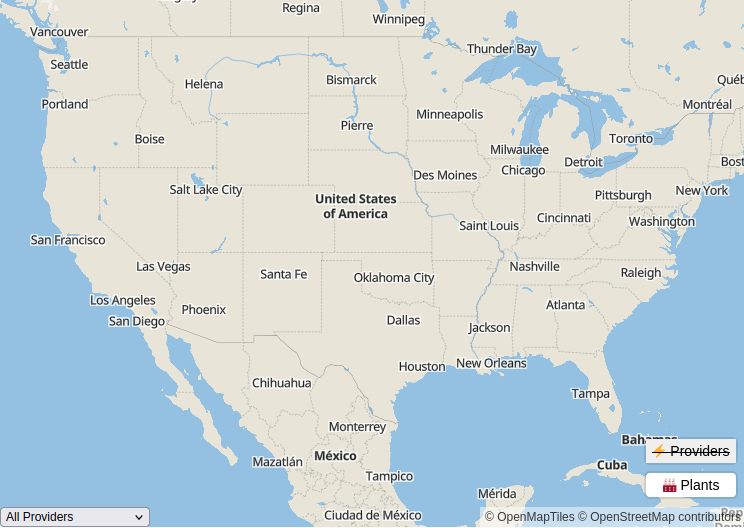Fremont Utilities
Electricity Rates, Plans & Statistics
High Power Bills?
Reduce or replace your electricity bill with solar
About Fremont Utilities
Fremont Utilities supplies electricity to 2 cities and is considered a municipally owned entity. Fremont Utilities' patrons spend, on average, 12.13 cents per kilowatt hour for their electricity, which is 7.23% above the average Nebraska rate of 11.31 cents and 23.03% lower than the nationwide average of 15.76. They had sales of 281,044 megawatt hours in 2022 via wholesale to other companies. The electricity sourced by the company is made up of multiple sources including megawatt hours they generate in their power facilities and other megawatt hours procured by way of the wholesale market. These categories make up 56.98% and 43.02%, respectively, of the total electricity sourced by the company. The total revenue for the company in 2022 from electricity sales was $54,429,700, with $6,301,700 coming from sales to the wholesale market and $48,128,000 from retail sales to end users.
The average residential electricity bill for a consumer of Fremont Utilities is $106.5. The company's electricity production plants generate 62,998.08 megawatt hours from the burning of natural gas. The provider generates 255th megawatt hours from non-renewable fuels per year. This makes them 5th in Nebraska out of 150 providers. They rank 421st in the United States out of the 3526 companies we track for their ratio of renewable versus non-renewable fuel types used.
Fremont Utilities allows consumers to take part in net metering programs. This makes it easier for residents in the area to install solar and other electricity options as they have the ability to sell unneeded wattage back into the grid.
All companies who transmit electricity suffer from some amount of energy loss via heat dissipation or alternative factors. Fremont Utilities is no different, as they have a yearly loss of roughly 0.01% of the total electricity they produce. These averages enable us to compare and contrast the numerous suppliers who operate throughout the United States. Fremont Utilities has earned a rank of 32nd best out of 3526 companies who report energy loss in the nation and best out of 150 in Nebraska.
Fremont Utilities Rate & Electric Bills
Fremont Utilities residential electric rates are highest in June and the highest average bill is in August.
Historical Electricity Rates:
Go Solar for less than your cell phone bill.
Fremont Utilities Overview
- Company Type:Municipal
- Headquarters:400 East Military Avenue
Fremont, Nebraska 68025
United States of America - Director/Superintendent:Joey Spellerberg
Fremont Utilities Contact
- Website:www.fremontne.gov
- Customer Service Phone:(402) 727-2630
- Social Media:
Fremont Utilities Service
- Rates & Plans:www.fremontne.gov
- Outage Phone:(402) 727-2600
- States Served:
- Nebraska
- Counties Served:
- Dodge County
- Major Cities Served:
- Fremont
- Inglewood
- Ames CDP
Quick Facts About Fremont Utilities
Fremont Utilities is faced with an average of 0.2 power outages per customer per year. These outages last an average of 15.15 minutes. Compare these numbers to the nationwide averages of other companies at 1.45 outages per consumer and 171.11 minutes per outage.
Fremont Utilities has no electricity generation sources and must purchase all of the electricity they sell to consumers.
Fremont Utilities generates 4,529 megawatt hours of electricity (or 1.01% of their total production) from solar power sources.
Based on total customers, Fremont Utilities is the 9th largest company out of 150 suppliers in the state.
Fremont Utilities is 5th out of 150 electric suppliers in the state for total megawatt hours produced from coal.
As the 285th largest producer of electricity in the US, Fremont Utilities produces 447,824 megawatt hours of electricity.
Energy Loss
Fremont Utilities' energy loss due to business operations.
Total Energy Loss
102MWh
32 National Rank
Grid Reliability
Length & Frequency of Fremont Utilities' Power Outages
15.15 min.
vs. national average of 171.11 min.
0.2 outages/yr
vs. national average of 1.45
Go Solar for less than your cell phone bill.
Fremont Utilities Coverage Map

Fremont Utilities State Coverage
| State | Customers | Sales ($) | State Rank Based On Revenue | % of Provider's Residential Sales in State |
|---|---|---|---|---|
| Nebraska | 16,429 | 52,704,686 | 9 | 100% |
Fremont Utilities County Coverage
| County | Population | Providers | Avg. County Rate (¢) | Avg. Electric Bill |
|---|---|---|---|---|
| Dodge County | 37,249 | 6 | 12.84 | $155.13/mo |
Cities Fremont Utilities Has Coverage
- Fremont, NE
- Inglewood, NE
* City coverage generated based on government data. Always verify you can get service from the provider.
Fremont Utilities Reviews
Write a Review of Fremont Utilities
Fremont Utilities FAQ:
Who is the CEO of Fremont Utilities?
The current CEO of Fremont Utilities is Joey Spellerberg.
What percentage of Fremont Utilities' electricity is produced using renewable fuel sources?
Fremont Utilities produces 1.01% of their electricity from renewable fuels.
How much is the average bundled bill for Fremont Utilities customers each month?
Consumers of Fremont Utilities pay, on average, a monthly bundled bill of $106.50.
What is the phone number for Fremont Utilities?
The Fremont Utilities phone number is (402) 727-2630.
What cities does Fremont Utilities have customers in to?
Fremont Utilities serves 2 cities.
What is the average bundled electricity rate for Fremont Utilities customers?
Consumers of Fremont Utilities, on average, have an electricity bundled rate 12.13 cents per kilowatt hour (¢/kWh).
What percentage of Fremont Utilities' electricity is generated using nonrenewable fuel sources?
Fremont Utilities generates 98.99% of their electricity from nonrenewable fuel sources.
When will Fremont Utilities power be restored?
Fremont Utilities' outages last, on average, about 15.15 minutes per each outage.